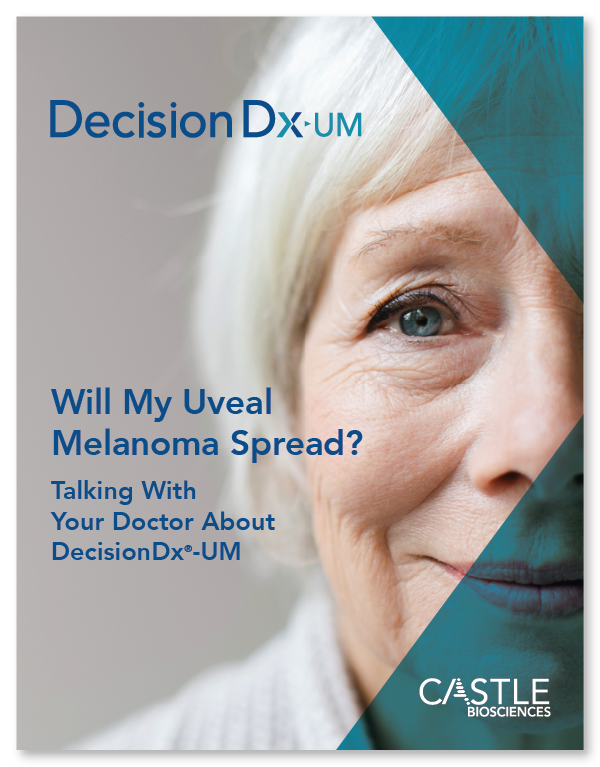Frequently Asked
Questions About
DecisionDx®-UM Testing
DecisionDx-UM is a gene expression profile test (GEP) that tells you how likely your uveal melanoma is to metastasize, or spread to other parts of the body. This prognostic test was developed by ocular oncologist Dr. J. William Harbour while at Washington University in St. Louis, (now at Bascom Palmer Eye Institute) and exclusively licensed to Castle Biosciences Inc., a molecular diagnostic laboratory.
The DecisionDx-UM GEP test has been available for routine clinical use since late 2009 and has been adopted by the majority of ocular oncologists in the U.S. as standard of care in the management of eye cancer.
The DecisionDx-UM test screens the gene expression profile of the uveal melanoma tumor. Specifically, it determines the unique activity of a set of 15 genes to identify the likelihood that the tumor has already spread from the eye.
A small sample of the tumor tissue must be taken before radiation therapy is administered, or from the enucleated (removed) eye. Castle Biosciences’ lab typically reports results within two to three weeks of receiving the tissue sample from the treating physician.
DecisionDx-UM can tell you whether your eye tumor falls into one of three classes, identifying the statistical risk of metastasis over the next five years, the period for which scientific data has been collected. These include:
Class 1A: Low risk, with a 2% chance of the eye cancer spreading over five years
Class 1B: Intermediate risk, with a 21% chance of metastasis over five years
Class 2: High risk, with 72% chance of metastasis over five years
If you choose to have the test, it’s important to know that timing is critical. For patients undergoing radiation treatment, a small sample of the tumor tissue must be taken before surgery since radiation may alter the genes in your tumor and skew the lab results.
If the treatment plan is enucleation, or removal of the eye, the tumor sample can be provided either from a biopsy taken at the time of enucleation, or by obtaining tissue slides from the wax block made following surgery and maintained in the pathology lab.
The DecisionDx-UM test can only be ordered by your physician or other appropriate healthcare provider—usually an ocular oncologist, retinal specialist, or ophthalmologist.
Currently, a majority of ocular oncology specialists in the country offer DecisionDx-UM to their patients. If your doctor does not perform the test and you would like further information or need help finding a physician who does, you can call customer service at 866-788-9007.
DecisionDx-UM results provide critical prognostic information for you and your doctor to determine the most appropriate plan for monitoring for metastatic disease and potential treatment. While the test cannot, at this point, guide your doctor toward a specific treatment, two recent studies show that the results are being used to:
The DecisionDx-UM test requires a tiny sample of your tumor, commonly taken with a very thin needle (called a fine needle aspirate biopsy or FNAB). If you are having radiation treatment, your doctor must take the sample before surgery.
Thousands of biopsy procedures have been performed safely in uveal melanoma, and the literature suggests that complications are rare. However, as with any surgical intervention, the potential risks should be fully discussed and considered with your doctor.
The DecisionDx-UM test is the most accurate prognostic test for uveal melanoma available. It is the only test that has undergone extensive validation by multiple studies, including an independent, prospective study of 494 patients conducted by the Collaborative Ocular Oncology Group (COOG). The results were published in Ophthalmology in August 2012, and showed that the GEP test could successfully classify tumors more than 97 percent of the time.
The DecisionDx-UM test measures the expression levels of 15 genes whereas chromosome 3 tests look to see if one copy of chromosome 3 has been lost (monosomy 3) or if there are two copies (disomy). In a head-to-head comparison (COOG study described above), DecisionDx-UM was found to be superior to chromosome 3 testing in predictive accuracy and technical reliability for returning a result.
Castle’s Patient Access Team can help with insurance information and financial assistance services. Castle will submit insurance claims for DecisionDx-UM testing and track the claim throughout the process. Castle offers an industry-leading financial assistance program for both insured and uninsured patients. For more information regarding billing and to qualify for financial assistance, call 866-788-9007 and select option #3.
Castle can readily accept international orders and will work with your physician to make sure the sample is shipped in the appropriate conditions to our laboratory. International orders are charged at full list price.
The program allows a DecisionDx-UM patient to store a sample of their tumor tissue free of charge for up to five years. Availability of the tissue for analysis would allow patients to take advantage of emerging targeted treatments, clinical trials, and further prognostic tests as they become available.
Learn How DecisionDx®-UM
Can Help Determine
Your Personalized Risk

Hear From Other Patients
Learn How DecisionDx-UM Has Made a Significant Impact on the Lives of Other Uveal Melanoma Patients.


